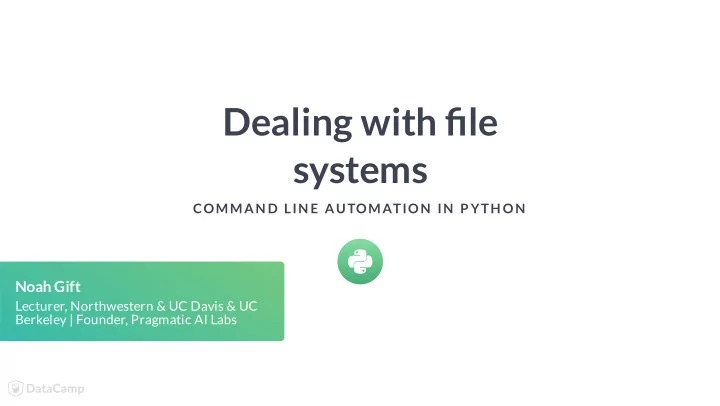

Dealing with �le systems COMMAN D LIN E AUTOMATION IN P YTH ON Noah Gift Lecturer, Northwestern & UC Davis & UC Berkeley | Founder, Pragmatic AI Labs
Computer User log �les build artifacts directory trees structured data unstructured data ML models COMMAND LINE AUTOMATION IN PYTHON
Filesystem File system is a hierarchy The Unix tree command ??? Makefile ??? README.md ??? demos ? ??? flask-sklearn ? ? ??? Dockerfile ? ? ??? Makefile ? ? ??? README.md ? ? ??? app.py ? ? ??? ml_prediction.joblib COMMAND LINE AUTOMATION IN PYTHON
Human User con�g �les user pro�le data business documents code data science projects ML models COMMAND LINE AUTOMATION IN PYTHON
Leaning into os.walk os.walk returns: root dirs files Returns a generator # generator only returns a result at a time foo = os.walk("/tmp") type(foo) generator COMMAND LINE AUTOMATION IN PYTHON
Finding �le extensions splitting off a �le extension fullpath = "/tmp/somestuff/data.csv" _, ext = os.path.splitext(fullpath) '.csv' COMMAND LINE AUTOMATION IN PYTHON
Let's practice. COMMAN D LIN E AUTOMATION IN P YTH ON
Find �les matching a pattern COMMAN D LIN E AUTOMATION IN P YTH ON Noah Gift Lecturer, Northwestern & UC Davis & UC Berkeley | Founder, Pragmatic AI Labs
Using Path.glob() Path.glob() �nds patterns in directories yields matches can recursively search COMMAND LINE AUTOMATION IN PYTHON
Simple glob patterns from pathlib import Path path = Path("data") list(path.glob("*.csv")) [PosixPath('mydata.csv'), PosixPath('yourdata.csv')] COMMAND LINE AUTOMATION IN PYTHON
Recursive glob patterns from pathlib import Path path = Path("data") list(path.glob("**/*.csv")) [PosixPath('data/one.csv'), PosixPath('data/moredata/two.csv')] COMMAND LINE AUTOMATION IN PYTHON
Using os.walk to �nd patterns os.walk pattern matching more explicit can explicitly look at directories or �les doesn't return Path object import os result = os.walk("/tmp") # consume the generator next(result) # Find your pattern here.... COMMAND LINE AUTOMATION IN PYTHON
Using fnmatch Supports Unix shell wildcard matches Can be converted to regular expression if fnmatch.fnmatch(file, "*.csv"): log.info(f"Found match {file}") COMMAND LINE AUTOMATION IN PYTHON
Converting fnmatch to regular expression fnmatch.translate converts pattern to regex import fnmatch, re regex = fnmatch.translate('*.csv') pattern = re.compile(regex) print(pattern) re.compile(r'(?s:.*\.csv)\Z', re.UNICODE) pattern.match("titanic.csv") <re.Match object; span=(0, 11), match='titanic.csv'> COMMAND LINE AUTOMATION IN PYTHON
Let's practice! COMMAN D LIN E AUTOMATION IN P YTH ON
High-level �le and directory operations COMMAN D LIN E AUTOMATION IN P YTH ON Noah Gift Lecturer, Northwestern & UC Davis & UC Berkeley | Founder, Pragmatic AI Labs
Two powerful modules shutil : high-level �le operations copy tree delete tree archive tree tempfile : generates temporary �les and directories COMMAND LINE AUTOMATION IN PYTHON
Using shutil.copytree Can recursively copy a tree of �les and folders from shutil import copytree, ignore_patterns Can ignore patterns copytree(source, destination, ignore=ignore_patterns('*.txt', '*.excel')) COMMAND LINE AUTOMATION IN PYTHON
copytree in action In [1]: pwd Out[1]: '/private/tmp' In [2]: !mkdir sometree && touch sometree/somefile.txt In [3]: from shutil import copytree In [5]: copytree("sometree", "newtree") Out[5]: 'newtree' In [6]: !ls -l newtree/ total 0 -rw-r--r-- 1 noahgift wheel 0 May 19 20:08 somefile.txt COMMAND LINE AUTOMATION IN PYTHON
Using shutil.rmtree Can recursively delete tree of �les and folders from shutil import rmtree rmtree(source, destination) COMMAND LINE AUTOMATION IN PYTHON
Using shutil.make_archive Archiving a tree with make_archive from shutil import make_archive make_archive("somearchive", "gztar", "inside_tmp_dir") '/tmp/somearchive.tar.gz' COMMAND LINE AUTOMATION IN PYTHON
Automation Takeaways Use the Python standard library If an automation tasks requires a lot of code The approach may be incorrect Consult the Python standard library Look at 3rd party Python libraries The less code you write, the less bugs you have COMMAND LINE AUTOMATION IN PYTHON
Practicing high-level automation COMMAN D LIN E AUTOMATION IN P YTH ON
Using pathlib COMMAN D LIN E AUTOMATION IN P YTH ON Noah Gift Lecturer, Northwestern & UC Davis & UC Berkeley | Founder, Pragmatic AI Labs
Using pathlib.Path from pathlib import Path Make a path object path = Path("/usr/bin") List items in directory as object list(path.glob("*"))[0:4] [PosixPath('/usr/bin/link'), PosixPath('/usr/bin/tput'), COMMAND LINE AUTOMATION IN PYTHON
Working with PosixPath objects mypath.cwd() PosixPath('/app') mypath.exists() True COMMAND LINE AUTOMATION IN PYTHON
More PosixPath mypath.as_posix() '/usr/bin/link' COMMAND LINE AUTOMATION IN PYTHON
Open a �le with pathlib Open a Makefile from a path object from pathlib import Path some_file = Path("Makefile") Print the last line of the Makefile with some_file.open() as file_to_read: print(file_to_read.readlines()[-1:]) ['all: install lint test\n'] COMMAND LINE AUTOMATION IN PYTHON
Create a directory with pathlib Path objects can create directories from pathlib import Path tmp = Path("/tmp/inside_tmp_dir") tmp.mkdir() Contents of the directory ls -l /tmp/ inside_tmp_dir/ COMMAND LINE AUTOMATION IN PYTHON
Write text with pathlib write_text() is a serious shortcut write_path = Path("/tmp/some_random_file.txt") write_path.write_text("Wow") 3 print(write_path.read_text()) 'Wow' COMMAND LINE AUTOMATION IN PYTHON
Rename a �le with pathlib renaming a �le with pathlib from pathlib import Path # Create a Path object modify_file = Path("/tmp/some_random_file.txt") #rename file modify_file.rename("/tmp/some_random_file_renamed.txt") ls /tmp some_random_file_renamed.txt COMMAND LINE AUTOMATION IN PYTHON
Practicing with pathlib COMMAN D LIN E AUTOMATION IN P YTH ON
Recommend
More recommend